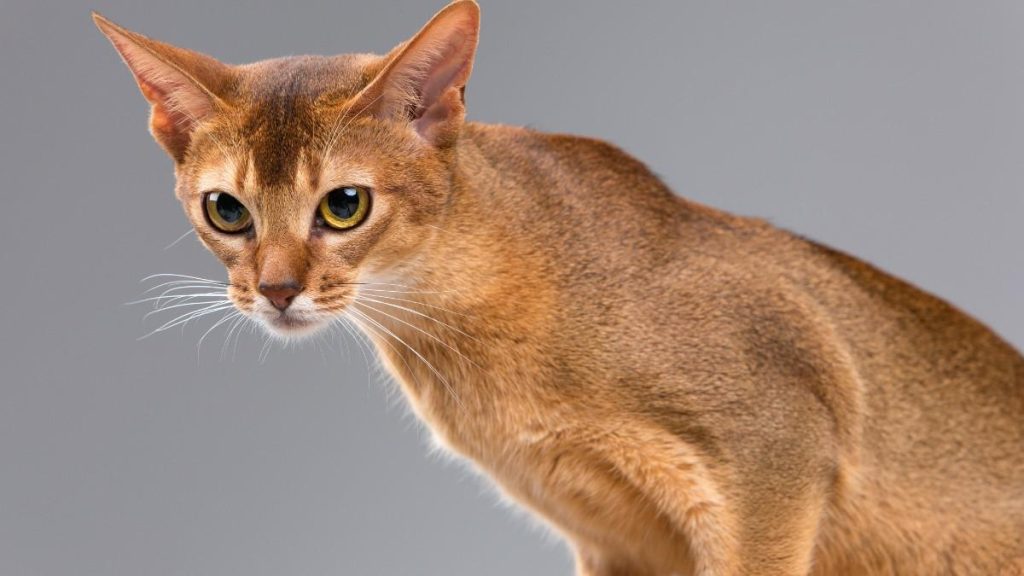There’s something irresistibly enchanting about the Abyssinian cat. With its unique mix of exotic appearance, friendly personality, and deep historical story, this breed has a way of quietly slipping into your life—and heart—almost effortlessly. From ancient Egypt to the modern home, Abyssinian cats have left paw prints across continents and centuries.
They’re not just pets, they’re companions with a rich past, tied to Pharaohs, paintings, and even a British soldier who once adopted a tiny, female kitten named Zula in 1868. Whether you’re drawn to their distinct orange color, their large ears, or their sweet, energetic nature, there’s no denying the Abyssinian‘s power to captivate.
So, what makes them so popular, yet not so common? Why do so many adoption seekers consider themselves lucky just to find one at a shelter or event? This blog post explores all that and more—what makes them special, what you need to know before buying, and how to care for them each month.
Why Choose an Abyssinian Cat?
Choosing an Abyssinian cat isn’t just about looks—it’s about embracing a breed with deep historical and emotional value. The first official Abyssinian was listed in 1882, but her roots go back to Zula, a cat taken by a British soldier from the port of Alexandria in 1868. Though there’s no proof she was the first, her story lives on.
Some say this domestic cat originated in Egypt, while others suggest a line stretching from the coast of the Indian Ocean to parts of South East Asia. Recent genetic studies have revealed strong ties across these regions. Their sleek coats resemble sculptures and paintings of Pharaohs’ times, making them look like they walked out of history.
But it’s not all about the past. Their sweet, friendly nature and distinct appearance—from the orange color to the large ears—make them a joy today. Though not a common type, those who get an Abyssinian know it’s worth it. They’re smart, active, and loyal. This guide will cover the cost, the care needed each month, and what to know before getting one of your own. If you’re wondering how much it does cost, or what makes them stand out—you’re in the right place.
History and Origin of the Abyssinian Cat
When I first saw an Abyssinian cat, its graceful posture and wild beauty instantly drew me in. Its elegant appearance and short coat reminded me of the ancient cats artists painted in Egypt. Many cat lovers consider it one of the oldest domesticated breeds, though its origin remains wrapped in mystery and romantic tales. People once believed the breed came from Egypt, but modern geneticists and studies reveal a more complex history. The name “Abyssinian” likely came from a cat that British troops brought to the UK after leaving Abyssinia in 1868. That cat, named “Zula“, appeared at the Crystal Palace exhibition in 1871. However, many experts now believe that Zula didn’t truly represent the Abyssinian breed as we know it today.
Some studies say the breed’s roots lie along the coast of the Indian Ocean, specifically in Southeast Asia, with parts of India and Asia playing a role in its spread. The breed may also closely resemble cats from ancient Egyptian sculptures, but others see links to the Caffre Cat or Felis Libyca, the founder of many domestic cats.
I saw an exhibit at a museum in Holland from 1834–1836, labeled “Patrie, domestica India“, which hinted at an Indian connection long before anyone showed an Abyssinian in England. Authors like John Jennings in 1893 and Harrison Weir in 1889 debated whether breeders imported the breed or created it by crossing English wild cats with domestic lines. Others, like Frances Simpson in her 1903 book, described Abyssinians with ringed tails, stripes, and features that might not match today’s standard, but still contribute to its evolving story.
Physical Characteristics of the Abyssinian
The Abyssinian cat is renowned for its striking appearance, characterized by:
- Coat: The Abyssinian cat has one of the most distinct and graceful appearances in the feline world. What immediately stands out is its short, fine coat, which often shines with a warm ruddy or reddish-brown color that can sometimes lean towards blue, fawn, or cinnamon, depending on the genetic line. The coat has a unique ticked pattern where each hair is banded with multiple colors, giving the fur a shimmering, textured look that’s unmistakably Abyssinian. This ticking, also seen in wild cats, makes the breed look both exotic and noble. I remember seeing an Abyssinian under sunlight—it was like the coat came to life with every movement.
-
Build: Their body is sleek, muscular, and medium-sized, with a slightly arched back and an elegant posture. The legs are long and slender, and the paws are oval-shaped, giving the Abyssinian a light, graceful walk. The tail is long and tapers at the end, matching the cat’s overall balance and symmetry.
Though they look refined, these cats are strong, agile, and full of energy. Their appearance is often compared to ancient Egyptian statues and sculptures, which many believe the breed may have resembled even in early paintings. Whether you meet one at a cat show, in a pedigree chart, or through an old book, the Abyssinian’s appearance will always impress with its wild beauty and elegant build. - Eyes: Their eyes are another remarkable trait—almond-shaped, expressive, and typically in shades of green, hazel, or gold, which contrast beautifully with their coat. A fine dark line runs around the eyes like natural eyeliner.
- Ears: Their ears are relatively large, wide at the base, and gently pointed, often tilting forward with alertness, adding to their inquisitive expression.
Personality and Temperament
Abyssinians are often described as the “eternal kittens” of the cat world. Their playful and curious nature makes them delightful companions for families and individuals alike. Key traits include:
- Intelligence: Abyssinians are highly intelligent cats that thrive on mental stimulation. They enjoy puzzles, interactive toys, and games that challenge their minds.
- Social Nature: This breed is known for its affectionate and people-oriented personality. Abyssinians form strong bonds with their human families and are often found following their owners from room to room.
- Energy: Abyssinians are active and adventurous cats that love to climb, jump, and explore their surroundings. Cat trees, shelves, and plenty of playtime are essential to keep them entertained.
- Curiosity: These cats are natural explorers and often investigate every nook and cranny of their environment. Their inquisitive nature can sometimes lead to mischief, so be prepared for their antics!
Caring for an Abyssinian Cat
While Abyssinians are generally low-maintenance cats, proper care is essential to ensure their health and happiness:
- Grooming: In terms of grooming, the Abyssinian’s short, fine coat is low-maintenance. Weekly brushing is usually enough to keep their fur looking sleek and to reduce shedding. They rarely need baths unless they get into something messy. Regular nail trimming, ear cleaning, and dental care are also part of a healthy grooming routine. When it comes to feeding, high-quality protein-rich food supports their muscular build and high energy levels. Since they’re a naturally lean breed, overfeeding should be avoided, and fresh water should always be available.
- Diet: A high-quality, protein-rich diet is crucial to support their active lifestyle. Consult your veterinarian to determine the best food for your Abyssinian.
- Exercise: Caring for an Abyssinian cat isn’t difficult, but it does require a thoughtful and consistent approach. These cats are incredibly active, intelligent, and curious, so daily mental stimulation and physical exercise are key. Interactive toys, climbing trees, and puzzle feeders help them stay engaged and happy. A bored Abyssinian can quickly become mischievous, so playtime isn’t just recommended—it’s essential. I’ve personally found that my Aby loves exploring every corner of the house and even “talking” back when you call their name.
- Health: Routine vet checkups and vaccinations help ensure long-term health, especially since some Abyssinians can be prone to genetic conditions like gingivitis or kidney issues.
Fun Facts About Abyssinian Cats
- The Abyssinian is often compared to small wildcats due to its lithe build and ticked coat.
- They are known to “help” their owners with tasks, often inserting themselves into activities like typing on a computer or reading a book.
- Abyssinians are one of the few cat breeds that enjoy playing with water, making bath time a little less daunting!
Conclusion
The Abyssinian cat is far more than just a beautiful feline—it’s a living piece of history with roots stretching back to ancient times, woven with stories of Egyptian sculptures, British soldiers, and worldwide admiration. From mysterious origins across Asia and the Indian Ocean to modern catteries in Europe, America, and beyond, the Abyssinian has earned its place as one of the most beloved breeds in the world.
Its elegant appearance, intelligent nature, and affectionate personality make it a perfect companion for those ready to offer attention, play, and care. Whether you’re drawn in by their shimmering ticked coats, expressive eyes, or rich cultural backstory, one thing is certain—Abyssinians don’t just live in your home; they live in your heart. visit CatsBreedHub.
Frequently Asked Questions (FAQs)
1. Where did the Abyssinian cat originate from?
Although originally thought to come from Egypt, recent genetic studies suggest the Abyssinian cat may have originated along the coast of the Indian Ocean and parts of Southeast Asia, including India. The name likely came from a cat brought to England from Abyssinia (Ethiopia) in 1868.
2. Who was Zula, and why is she important?
Zula was the name of a female Abyssinian kitten believed to be the first of her breed brought to England by a British soldier after the Abyssinian War. Although her physical traits didn’t fully match modern Abyssinians, she remains an iconic figure in the breed’s history.
3. Are Abyssinian cats really connected to ancient Egypt?
Many people believe that Abyssinians resemble the cats seen in ancient Egyptian paintings and sculptures. While this adds a romantic charm, there is no solid proof—only visual resemblance.
4. When was the Abyssinian breed officially recognized?
The GCCF officially recognized the Abyssinian in England in 1929. Breeders recorded the first American litter in 1935, and the breed quickly spread to countries like France, Holland, New Zealand, and Australia.
5. What are the physical characteristics of the Abyssinian cat?
The Abyssinian has a slender, muscular body, a short ticked coat, large ears, and expressive almond-shaped eyes. Their fur often appears ruddy, blue, fawn, or cinnamon, with a glowing, shimmering texture.


